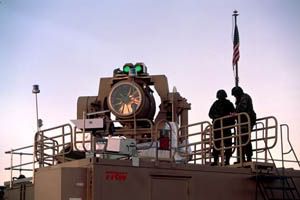|
August 10, 2006, 3:16 a.m.
Why Do Katyushas Have Free Rides?
The stifling of a promising defense.
By Angelo M. Codevilla
As thousands of artillery rockets fall on Israel, all too few people know that an excellent device for intercepting them has been available for about seven years, but that Israeli and American officials, who should have known better, decided not to deploy it.
Katyusha rockets from Lebanon have been falling on Kyriat Shemona and in the neighboring vicinity for more than two decades. They are Soviet-army surplus from World War II, when they were known as the “Stalin Organ” because their organ-like launchers used to disgorge them by the thousands. Though not terribly effective against armies, they can make normalcy impossible for civilians. Serious military people have long recognized that protecting northern Israel against them is essential to the country’s survival.
The technical problem in defending against them is simply that their flight time — and especially the time from their appearance over the horizon to their impact — is too short for any normal interceptor to get to them. Moreover, the Katyushas are so cheap and numerous, and individually so ineffective, that even if it were possible to build an interceptor, it wouldn’t be worth deploying it for each rocket. The only force that could destroy the Katyushas in flight would be multi shot, directed energy weapons.
In the 1990s, the makings of such weapons were very much in hand. By 1998, the prototype THEL (Theater High Energy Laser) was blowing up Katyushas in flight at White Sands Proving Grounds, New Mexico, by exploding their warheads with heat. By the following year it was ready to go to Israel.
How that weapon was developed and why it was not deployed is pregnant with lessons as relevant to America as to any other part of the world. THEL was put together with elements that had been developed in the 1980s as parts of the U.S. Space Laser program. Making them into a ground-based weapon actually involved more technical complications than did the space version. For example, the space version of the device’s pointing and tracking system needed to move only a few degrees, because space targets would have been far away. But to track nearby Katyushas, its detectors and software had to move much more, and fast too. The space version relied on the vacuum of space to produce the negative pressures essential to turning chemical combustion into light. But the ground version had to produce vacuum exhausts for each shot. Nevertheless, within about two years, the THEL was …. where it is today, in New Mexico.
The lessons are twofold. First, Israeli and American officials decided not to deploy a workable defense against an obvious, deadly threat because, following the flawed McNamara logic of almost a half century ago, that defense was not “cost effective.” True — it would cost more to defend against Katyushas than to buy and shoot them. But consider the cost of not defending against them: the enemy was able to make a big chunk of the country uninhabitable. This retail wisdom and wholesale stupidity continues to convince U.S. military officials to divert resources from defending the U.S. population against missiles. The various rationales — we can rely on more potent deterrent forces, on “diplomacy,” on new research — have the same result: no missile defense.
Second, the fact that a ground-based version of a space-based laser became a deployable weapon quickly, despite being a bigger technical challenge than the space version, makes clear to all who know the field just how feasible is a defense against those longer range missiles that pose dangers much greater than Katyushas. A few officials of the Bush administration know the facts, and they (privately) regret that George W. Bush and his principal advisers have decided that building space lasers would needlessly upset the Russians and Chinese. Most military officials, who would prefer to spend money on armored Humvees, helicopters, ships, and planes, are not about to argue with their bosses.
And yet it should escape no one that Iran, Syria, and North Korea — not to mention China and Russia — have learned from what has been happening in Israel that a Western country can be hit by ballistic missiles, parts of it can be made uninhabitable, and the West’s retaliation will not aim at undoing those who are responsible for launching the missiles. In short, they have learned that American (never mind European) officials who refuse to build missile defenses are also likely to respond ineffectively to missile attacks.
How different would the Middle East look today if several THEL units were in Israel? How different would the world look if, when Iran has its nuclear-tipped Shahab -4 missiles, the U.S. also had a fleet of space lasers?
—Angelo M Codevilla is professor of international relations at Boston University and the author of While Others Build and Missiles, Defense, and Israel.
|


 , But maybe it would be better to just send over the laser they were talking about in the article
, But maybe it would be better to just send over the laser they were talking about in the article